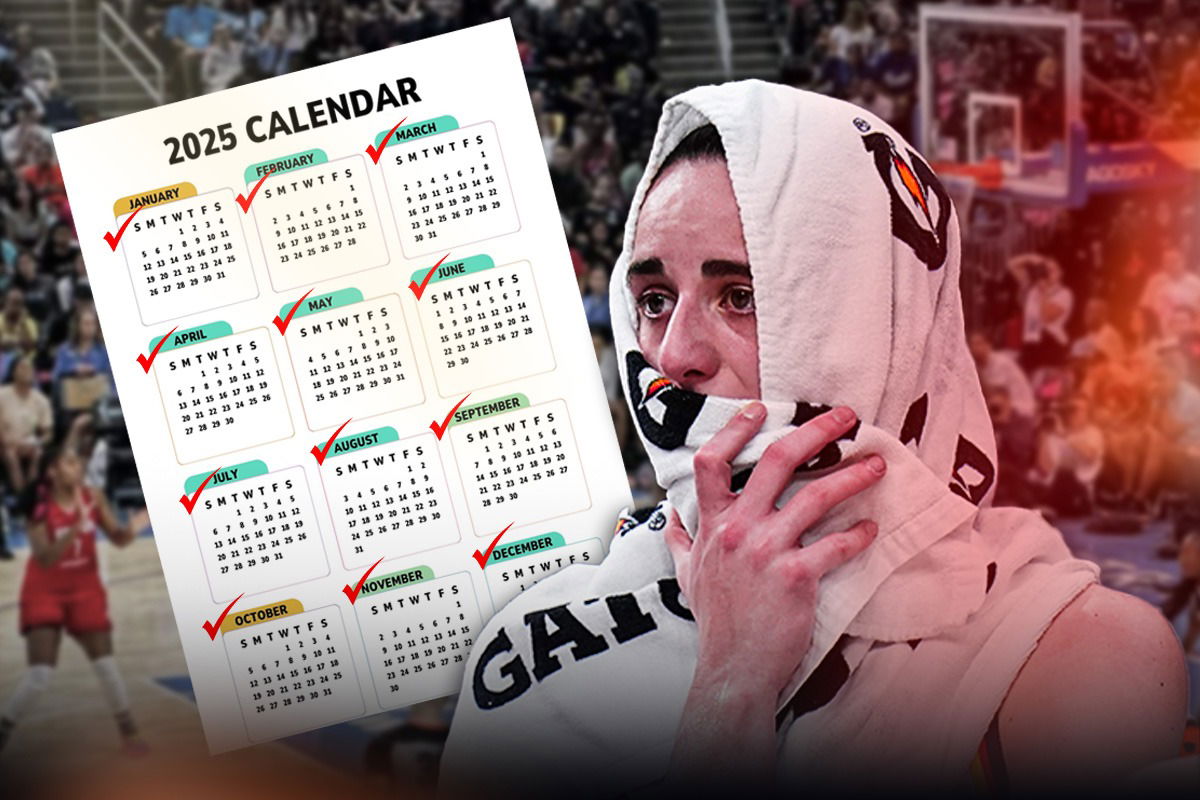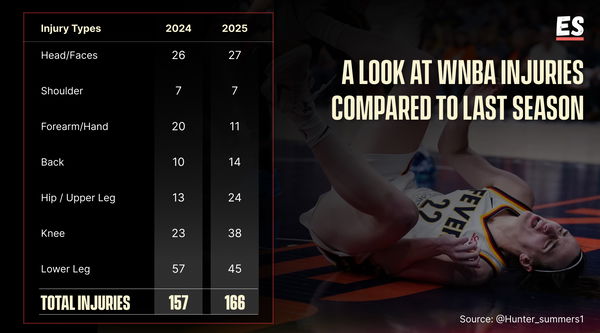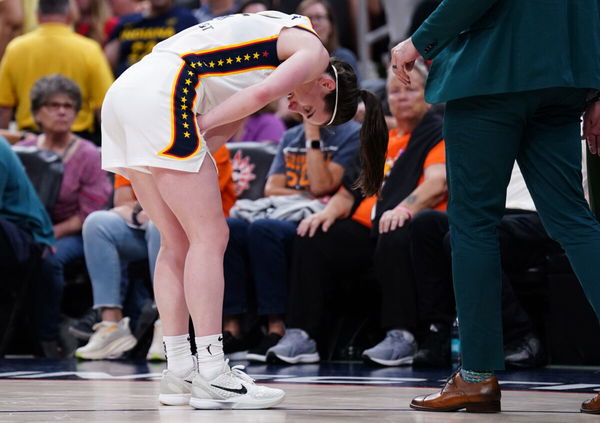
Imago
Credits : Imagn

Imago
Credits : Imagn
In the dreamscape of sports, fans love to live in an endless loop. Prime time. Packed arenas. Rivalries. Wins. Hopes that we will come back stronger, live rent-free. Leagues know this. And they’re delivering—more games, behind-the-scenes access, and moments. Every calendar is stretched thin to its finest thread of mozzarella. The offseason is truly set to disappear, if it hasn’t already. And the WNBA stands as the clearest example.
Watch What’s Trending Now!
In May 2023, it was one of WNBA Commissioner Cathy Engelbert’s interviews that brought smiles.
“The first thing when I came in, I said, ‘OK, we have 12 teams in a country of over 300 million people. That is not enough.”
ADVERTISEMENT
A few months later, she delivered. In October 2023, the Commissioner announced the addition of the Golden State Valkyries, and excitement swept through the league. Fast forward to 2025, and the Valkyries are already chasing playoffs in their debut season.
But the expansion doesn’t stop at 13.
Portland and Toronto are suiting up for 2026, taking the total number of teams to 15. But that won’t be enough either. “The demand for women’s basketball has never been higher, and we are thrilled to welcome Cleveland, Detroit, and Philadelphia to the WNBA family,” said WNBA Commissioner Cathy Engelbert, taking the total to 18 teams by 2030!
ADVERTISEMENT
Yes, the demand for more exists. And it is a win for women’s basketball. But for the players, it is a different story.
With pay and workload tensions already a recurring headache, players were now being forced to squeeze in four more games on top of an already brutal schedule (jumped from 40 to 44). That’s basically asking for trouble, because it isn’t stopping at 44… and to nobody’s surprise, injuries were stacking up faster than Caitlin Clark ticket prices on game night.
ADVERTISEMENT
LA Sparks coach Lynne Roberts struck a chord when she said: “I was just talking to my staff about it, wondering what do you think it is, why are there so many injuries? There’s probably a lot of reasons, and I think… you have to look at the whole calendar year for these athletes, not just the W season.” Most W players travel to China, Australia during the WNBA offseason, and now, Napheesa Collier’s Unrivaled has managed to woo the players, too.
| EssentiallySports’ take: Players may have a choice, but it’s an illusion! Financial realities push them to engage overseas in the offseason. A good CBA structure can change that. If demands are met this October, the number of players stepping out of the US will drop, helping the WNBA in the long run. |
Lynne Roberts’ comment: “They’re playing overseas, they’re not getting that break that most professional athletes get. There really is no offseason,” rings an alarm. But how accurate is her version of reality? We tracked the current injury landscape of the W… because an athlete’s worst nightmare is injury.
ADVERTISEMENT
Reality: Injuries hit hard across the WNBA this season
According to The IX Basketball’s injury tracker, in the 2025 calendar year (all numbers as of 1st September*):
- 232 players* have already spent time off the court
- Missing a total of 901 games* so far
- By comparison, in 2024, 203 players missed a combined 711 games. That’s a significant jump of 190 games since the addition of the Golden State Valkyries. The average isn’t good either. Jumped from 3.5 injuries per game in 2024 to 3.9* in 2025.
ADVERTISEMENT

ADVERTISEMENT
Analysis by Hunter Summers on X shows that the 2025 WNBA season has already seen an increase of 9 injuries as of August 19. The worst part: If injuries continue at this pace, the league could see up to 214 total injuries this season, which would be 57 more than last year. That’s a 36.3% projected rise.
Top Stories
Ravens’ Lamar Jackson Demands Short-Term Contract Away From NFL on Thursday

‘RIP’: NASCAR World Crumbles in Tears as 39-YO Former JR Motorsports Driver Passes Away

NASCAR President Kicks Up ‘SRX’ Firestorm With Courtroom Claim Fans Refuse to Accept

Watch: Scottie Scheffler Left Stunned as the Ball Betrays Him

Yankees Offensive Free agency Ends Early as Cody Bellinger-Kyle Tucker Pursuit Ends Before Beginning: ESPN Insider

Who are Fernando Mendoza’s Parents? All about Elsa Mendoza and Fernando Mendoza

Take Paige Bueckers’ rookie year as a study.
| PB entered the pros with high hopes, but sank with the Dallas Wings (last seed as of 1st September). The iceberg here? Injury. |
| By the end of this season, two-thirds (8 of 12) of the Wings’ original roster will have missed at least seven games! |
ADVERTISEMENT
It’s time to stop considering it bad luck, because it’s already a warning sign.
Last year, injuries dropped significantly after the Olympics break. This year, however, players haven’t had a similar break. Athletes like Napheesa Collier (7 games), Breanna Stewart (13), and Angel Reese (10) have all missed time because of injuries—a situation likely compounded by their offseason participation in Unrivaled. It’s easy to see why Lynne Roberts emphasized that playing year-round can have its consequences.
ADVERTISEMENT
Opinion: Why is Lynne Roberts spot on about the WNBA players’ desperate situation?
The WNBA added four extra games to the schedule this year following the inclusion of the Golden State Valkyries, which Satou Sabally called ‘terrible,’ since the season calendar wasn’t extended.
- The 2025 season spans over 114 days, excluding the All-Star break, compared to 102 days in 2024.
12 days seem manageable. However, in 2024, players also enjoyed roughly a month off for the Olympic break—a break that didn’t happen this year. With the W planning to expand to 18 teams by 2030, it’s clear that even more games will be added to the calendar, and that will only increase the rate of injuries if things remain the same. Precisely, the roster size.
The WNBA currently limits teams to just 12 players, with some even forced to run with 11 to stay under the hard cap. The Indiana Fever were a prime example of this earlier in the season. Unlike the NBA, the W doesn’t have the luxury of a 15-player roster or the G League.
Just like coach Lynne Roberts, LA Sparks’ Cameron Brink raised this issue: “Personally, I think roster sizes need to be expanded before we add any more expansion teams. Because it’s kind of crazy—12 people for a roster? It’s kind of insane.”

Imago
Jul 15, 2025; Boston, Massachusetts, USA; Indiana Fever guard Caitlin Clark (22) reacts with a possible injury after a play against the Connecticut Sun in the second half at TD Garden. Mandatory Credit: David Butler II-Imagn Images
Amid all the chaos, let’s not deviate from the core: Everyone wants the WNBA expansion. Fans demand it, and growth depends on it. The sport only thrives when the league spreads its wings across a bigger market. So, we get the point.
But expansion means nothing if the foundation—player safety—is overlooked.
Without protecting the athletes, what’s the point of building anything bigger?
The WNBA wants to prioritize its own interests by urging players to avoid playing in other leagues during the offseason. Players, in turn, prioritize theirs—chasing opportunities that pay far more. Unrivaled’s average salary of $220,000 nearly doubles the WNBA’s $102,249, making the choice obvious…
This is not rocket science we are ideating on. The math is pretty simple to me: the more games crammed into the calendar, the higher the risk of injuries—especially for athletes already grinding through overseas and offseason commitments. That’s why the WNBA and WNBPA must address this in the next CBA. But it isn’t just about pay when injury is at play. Bigger rosters and smarter scheduling are the way forward because these are basic protections for player health.
At the end of the day, the WNBA is what it is today because of its players. Fans don’t show up for logos; they show up for the women who make the game. Without them, there is no league… or expansion.
Thoughts?
ADVERTISEMENT
ADVERTISEMENT
ADVERTISEMENT

